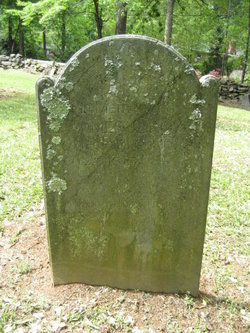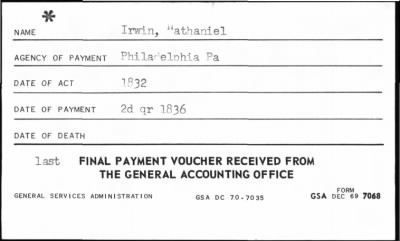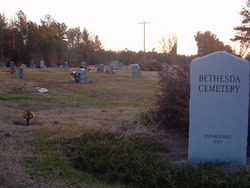Leah Julian, as many second wives were, was considerably younger than her husband and outlived him. And, as many widows did, she remarried. The unusual part was the fact that Leah, a woman of considerable wealth and standing, and of European extract, married a Native American, and her children removed from her afterward.
 |
| Monument to Nathaniel Erwin |
A small number of documents tell the story. A story I am not certain of it's validity. While I believe it is certainly true that Leah Julian Erwin was the widow of Nathaniel and the mother of his younger children, and that she apparently did marry James Crow, and that the court gave her children first to the care of her brother, I am not altogether certain that James Crow was an Indian.
Leah Julian was my 8th Great-Grandmother. This book takes the history of the Irvin/Irwin/Erwin family to it's very roots:
(1908)
Many other books, several focusing on the history of Burke County, North Carolina, focus on the sons of Nathaniel Erwin/Irwin, her first husband, but not as much information is available on Leah and the Julians.
The Julian's followed their daughter and son-in-law Nathaniel to York County, South Carolina during the years that it was yet untamed and considered the territory of the Catawba Nation. Historical belief recorded in family records states that George was injured in the Battle of Fort Dorchester, and died there of his wounds. Between Grants and purchases, George Julian acquired a great deal of land in North Carolina. It is known that he was living in Guilford County, North Carolina by 1755, next to his brother Isaac. Some researchers say he was a loyalist, and that his land was confiscated. Others dispute this belief, saying it was merely sold, 1788 by son and administrator Jacob Julian, for profit for the heirs.
On January 18, 1782, a woman named Jemima Ponder gave a deposition stating "she did live at the Creek Meeting House below Dorchester and that George Julian who did live on King's Creek in District aforesaid, was there and she said despondent did see the said George Julian depart this life between the first and middle of September in the year 1781."
Samuel Julian in Rutherford County by Bev Julian.
George's parents, and Leah's grandparents, were Pierre Rene de St. Julien and Mary Margaret Scotlay Bullock de St. Julien. The following story was found on Ancestry.com concerning the Julian family.
Pierre de St. Julien was born about 1641 in Vitre, Brittany, which is in the northwestern part of France. Research has not turned up any information regarding the history of the family prior to the 1600s, but the name, at one time, was prominent in Italy. A letter from a Vitre genealogist to a family researcher says, “There is no document in Vitre showing what province they came from before coming to Vitre. They are of nobility beyond doubt.” Pierre de St. Julien married Jeanne Lefebre in Vitre, and they had nine children. All were born in Brittany Province.
1.Aimee de St. Julien; born March 7, 1667.
2.Charlotte de St. Julien; born May 15, 1668.
3.Rene de St. Julien; born July 4, 1669.
4.Louis de St. Julien; born August 5, 1670.
5.Marguerite de St. Julien; born December 19, 1671.
6.Paul de St. Julien; born October 4, 1673.
7.Emilie de St. Julien; born January 10, 1675.
8.Jeanne Renee de St. Julien; born May 6, 1678.
9.Marie Ester de St. Julien; born December 14, 1679.
Most members of the St. Julian family in Brittany Province were Huguenot Protestants. After the Edict of Nantes was revoked in 1685—in effect making Protestantism illegal in France—many of the unfortunate Huguenots were massacred by Roman Catholics. At least 250,000 French Huguenots fled to countries such as Switzerland, Germany, England, America, the Netherlands, Poland and South Africa, where they could enjoy religious freedom.
The St. Julien family joined the migration, going firstto England, and later to Ireland. Many of the religious refugees were from distinguished families—some even had connections to nobility—andmanaged to take considerable wealth with them.
The Huguenots left France as a result of religious persecution, but in England they soonfound themselves again in the midst of religious controversy, this time Protestantism versus Catholicism. The Jacobite movement in Scotland was spilling over into England as well, and this—plus poor economic times—induced many Huguenots to move on to Ireland.
Those who went on to Ireland, where the majority of the population was staunchly Roman Catholic, found that while they weren’t persecuted like they had been in France, they were looked on as “outsiders.” This, and the depressive economic times, prompted many of this group to look to the American Colonies for a better life.
In France, and later in the British Isles, the Huguenots were known for their knowledge and skill in the textile industry. In America, in the late 1600s, South Carolina emerged as a leading locale for the textile industry in North America, and opened her doors to the Huguenots. Large numbers took advantage of the invitation; so many, in fact, that the area was soon known as “The Home of the Huguenots.”There were several organized congregations as early as 1685 in Charleston and the surrounding area.
Many members of the St. Julien family, including Rene St. Julien, as well his brother Louis and his brother-in-law Rene Ravenel, accepted South Carolina’s invitation, leaving Ireland in 1699. Rene, Louis Julian (note spelling change) and Rene Ravenel, and their respective families, settled in or near Jamestown, South Carolina. Rene’s parents, as well as some of his younger siblings, may have remained in Northern Ireland, for one source reports that Pierre died there.
The ship carrying Rene de St. Julien to the Colonies also carried the English Bullock (Bulloch) family. While en route it stopped off for water and other provisions at Bermuda. It would not have remained there long, but it was long enough for Rene to marry Mary Margaret Bullock. Rene and Mary had twelve children.
1.Stephen Julian, 1700-1773. He was born near Santee River, in Charleston Co., SC. He later lived in Prince George Co., MD. Married Allatha Buchelle about 1725. His second wife was Ann Hedges.
2.Infant, born 1701, died 1701.
3.Rene Julian, born 1704, and died about 1712 of “swamp fever.”
4.George Julian, 1706-1781; lived in Frederick Co., VA and later South Carolina.
5.Mary Julian was born about 1711 in Charleston Co., SC. She married John Thompson in1734.
6.Peter Julian was born in 1714 in Frederick Co., MD, and died in 1806. He married Mary Bahls, and lived in Orange Co., NC. He was listed as a “Capt.” in the 1790 census.
7.Isaac Julian was born December 30, 1716, in Anne Arundel Co., MD, and died in 1778. He married Barbara White, and lived in Randolph Co., NC.
8.Rene Julian was born in 1718 in Cecil Co., MD (it was a common practice to name a child the same as one who had died). He went to Georgia with Gen. Oglethorpe. He married Catherine Biggs.
9.Jacob Julian was born ca. 1720 and died in 1751. He married Catherine Hedges. His will was probated August 30, 1751 in Prince George Co., MD.
10.John Julian was born in 1721 in Cecil Co., MD, and died in 1762. He lived in Orange Co., NC, and married Elizabeth Trogden.
11.Catherine Julian was born about 1722 in Bohemia Manor, Cecil Co., MD. She married Joseph Wood III on September 11, 1747, in Frederick Co., MD.
12.Ruth (Ann) Julian was born 1724 in Bohemia Manor, Cecil Co., MD.
Rene St. Julien, as a young man, was a soldier in the army of King James II in the English Revolution of 1688, and was in his service during the Battle of the Boyne in Ireland, which occurred July 1, 1690. But he, like so many others, changed his allegiance King William. For his service to King William he received a grant of land somewhere beyond the Mississippi River. According to family tradition, he told his family that they could not really consider themselves settled until they were established there. But Rene never saw the land that was granted to him, and it is not known if any of his heirs ever claimed it.
A deed, recorded in the South Carolina Indentures for 1712, indicates that Rene St. Julianand his family, as well as his brother Louis, were living in the Charleston area. Sadly, however, Rene and his wife had earlier lost two young sons, probably to typhoid, also known as “swamp fever,” and decided to move to a more healthful climate. Records indicate that in late 1712 Rene St. Julian was living in Cecil County, Maryland. They livedthere until about 1740, then moved to Winchester, Virginia, where Rene died about 1744. Rene and his wife are both buried in the old Opequon Cemetery near Winchester.
George Julian married Martha Denton about 1728, probably in Cecil County, Maryland. She was born about 1708 in Cecil County, Maryland. At some point they moved to Frederick County, Virginia. Records indicated that George bought four hundred acres there in 1750, and sold the entire parcel in 1758. By 1766 the family was living in Mecklenburg County, North Carolina, for it is recorded that George bought three hundred acres there during that year. The family may have moved more during the next few years.The Craven County, North Carolina plat book, Volume 17, page 370, indicates that George bought one hundred and fifty acres in Craven County in 1772, and land records acres in York County, South Carolina show that he sold one hundred acres there in 1779.
George Julian was a Loyalist, and fought in the British Army during the American Revolution. He was wounded in
battle in September 1781, probably at the Battle of Fort Dorchester, and died shortly afterward. After his death Martha married a Mr. Black.
George and Martha had seven children. All were born in Cecil County, Maryland.
1.Jacob Julian was born about 1729.
2.George Julian II was born about 1731. He married Hannah, and they had three children. They settled in North Carolina, near what is today the town of Julian, near the borders of Randolph and Guilford Counties. George fought with the British at the Battle of Alamance in 1771, but Jesse Julian, one of his sons, fought with American forces against the British.
3.John Julian was born about 1734, and died in 1799.
4.Rachel Julian was born about 1735. She married Samuel Morse (Moss).
5.Mary Julian was born about 1740. She married Jonas Rodgers.
6.Samuel Julian was born about 1738, and died in 1851. He married Mary Condrey.
7.Leah Julian was born in 1743, and died in North Carolina in 1794. She married NathanielIrwin/Erwin, a thirteenth great-grandson of Sir William Irwyn. She was his second wife, and they had three children. Nathaniel was born about 1713 in Glencoe, Ulster, Northern Ireland. He was one of six children of Matthew Irvine and Elizabeth Patterson.
Shortly after the death of her first husband, Nathaniel Erwin, Leah Julian Erwin, as was custom of the day, remarried. The three youngest children of Nathaniel and Leah were underage. The York County court records contain the following document:
From Minute Book B, page 148, February Session, 1796
"On its appearing to the Court from sufficient testimony that Nathaniel Irwin, Sophia Irwin and James Irwin, the children of Nathaniel Irwin deceased, have not been taken due care of in their clothing and education by their Mother Leah Crow (late Leah Irwin) and it appearing that Jacob Julian together with the said Leah is appointed by the will of the said Nathaniel Irwin deceased to provide for & superintend the clothing and educating of the said children: the court do therefore order that the said Jacob Julian do take the said Children into his custody until they shall be of legal age to choose guardians for themselves, and that the said Julian do give bond & security to the Court, that he will Clothe and educate the said Children in a sufficient manner agreeable to an act of the General Assembly in that case made and provided."
Exactly one year later, in the February Session of Court in 1797, son Nathaniel Erwin, Jr. was back in court to chose his own guardian, and re-installed his uncle, Jacob Julian.

There is not a wealth of information available on James Crow. What is known is that he is buried in the Old Unity Cemetery in Fort Mill, York County, South Carolina with a date of death as October 16, 1801. A James Crow does appear in the 1790 census of Spatanburg, South Carolina, with one male and one female over 16. Two James Crow's appear in the 1800 census for an area, one younger with a smaller family.
Crow is not necessarily a Native American name. There is record of a James Crow, born about 1740 in Virginia, and of Crow's immigrating from Ireland. I am not disputing the claim, that he might have been Catawba, he lived in the right area to be, and the Erwin's were associated with the Catawba.
What is known is that he owned a good section of land and was also a slave owner. A family rumour recorded on Ancestry.com relates the following tale: Leah Julian became estranged from her family after the death of Nathaniel. She was briefly married to a prosperous Native American named James Crow, and shortly afterwards lost her mind and senses. The marriage lasted approximately 2 years before she passed away.
The following is the will of James Crow:
York County SC Will Book A-1 1800-1813, Pages 65-66: .....unto Jenney Crow my
little negro boy by the name of Squire & likewise to be schooled to common
English Scholler & said negro to be put out to hire for the use of s'd child & I
allow the sum of $40 to be laid out by my executors if they see that there is
occasion for cloathing for Jinney Crow; to my Stepson James Irwin when he
arrives to the age of 21 years, $50; the remainder of my negroes to be sold at
publick sale & my land likewise and the money arising from same & my whole
estate not already willed to be delivered to any one of my brothers (viz) Thomas,
Robert, Jason, of John Crow & for that one to divide the same into four equal
divisions for him to take one division and give the other three division to
three brothers above mentioned; I appoint my faithful friends Hugh White Esq,r
Capt. Thomas McNeal, & Andrew Elliott, exrs....
little negro boy by the name of Squire & likewise to be schooled to common
English Scholler & said negro to be put out to hire for the use of s'd child & I
allow the sum of $40 to be laid out by my executors if they see that there is
occasion for cloathing for Jinney Crow; to my Stepson James Irwin when he
arrives to the age of 21 years, $50; the remainder of my negroes to be sold at
publick sale & my land likewise and the money arising from same & my whole
estate not already willed to be delivered to any one of my brothers (viz) Thomas,
Robert, Jason, of John Crow & for that one to divide the same into four equal
divisions for him to take one division and give the other three division to
three brothers above mentioned; I appoint my faithful friends Hugh White Esq,r
Capt. Thomas McNeal, & Andrew Elliott, exrs....

 Christopher Columbus was, certainly not deserving of any celebration, no matter what his achievements.
Christopher Columbus was, certainly not deserving of any celebration, no matter what his achievements.
 The inscription on the tombstone of Nathaniel Irwin in Bethesda Cemetery, is said to contain incorrect information. The tombstone reads:
The inscription on the tombstone of Nathaniel Irwin in Bethesda Cemetery, is said to contain incorrect information. The tombstone reads: